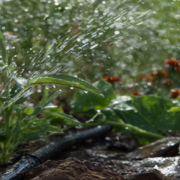Put Your Irrigation to the Test
Turn on each valve of your irrigation system, and observe how quickly water begins to run off your landscaping. Note the time when each runoff occurs. For some systems, this could be immediately. For others it may take as long as five minutes.
Make sure that the spray irrigation is never running for longer than eight minutes at any one time.
Take notes on your irrigation plan, and turn off your irrigation until you are able to fix the follow issues:
• Do you have broken sprinkler heads?
• Are there heads that are blocked by plants or objects such as planters or lights?
• When the system turns off, does water come out of the lowest heads in the landscape?
• Are any heads in need of adjustment to they don’t directly spray onto the hardscape, such as sidewalks or patios?
Adjust your sprinklers to eliminate runoff
Several things can be done to minimize runoff due to irrigation. This is among the most important factors in using irrigation efficiently.
• Tune up spray irrigation systems so there is no overspray on hard surfaces
• Do not install spray irrigation in areas that are too narrow (generally eight feet wide or narrower)
• Move spray heads 24 inches away from buildings or impermeable surfaces
• Convert spray systems to micro or drip irrigation with the lower precipitation rates, pressure regulation and a filter
• In lawn areas, be sure to follow the organic maintenance practices to keep your soil ‘spongy’
• Replace standard overhead sprayers with high-efficiency rotator nozzles, or other types of low precipitation rate nozzles
Staying on top of your irrigation system can mean the difference between maximizing your water efficiency and unknowingly wasting water running down sidewalks unused into the storm drain.
This article was inspired by the 71-page Sustainable Landscapes Program guidebook available at SustainableLandscapesSD.org. The Water Authority and its partners also offer other great resources for landscaping upgrades, including free WaterSmart classes at WaterSmartSD.org.



